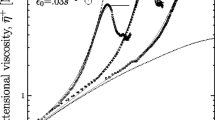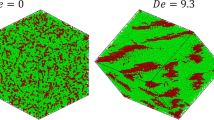Abstract
When a stick-slip transition of an extremely large magnitude occurs in capillary flow of a highly entangled melt, a significant flow can be generated in the barrel. At a constant piston pressure, this barrel flow reduces the actual pressure available at the die entry that produces the capillary flow in the die. Experiments on linear monodisperse polybutadienes (PBd) show that a significant correction due to this barrel flow must be made to obtain a reliable characterization of the interfacial stick-slip transition. The interfacial flow discontinuity transition exhibits hysteresis behavior similar to that of linear polyethylenes. When a large pressure loss occurs in the barrel due to a massive stick-slip transition, the die wall stress may drop below the hysteresis loop, causing a new self-regulated flow oscillation to take place at a constant applied pressure.
Similar content being viewed by others
Author information
Authors and Affiliations
Additional information
Received: 2 April 1998 Accepted: 1 June 1998
Rights and permissions
About this article
Cite this article
Yang, X., Wang, SQ., Halasa, A. et al. Fast flow behavior of highly entangled monodisperse polymers . Rheol. Acta 37, 424–429 (1998). https://doi.org/10.1007/s003970050129
Issue Date:
DOI: https://doi.org/10.1007/s003970050129




